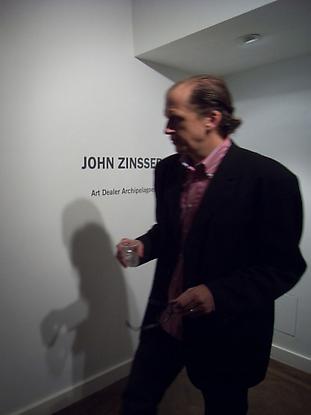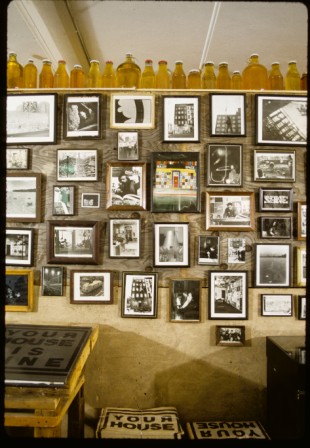reviews
Philip Guston: Small Oils 1969-1973 at MCKEE GALLERY
James Kalm is delighted to bring viewers along for a holiday stroll through this exhibition of small works by one of New York’s most influential painters. Executed during a five year period while Guston was developing his “Hooded Figure” and “Roma” series, these pieces show the concentration and focus the artists was bringing to his return to figuration. Divided into four categories - single objects, hoods, city scapes and studio interiors - these small pictures retain their power despite their size, and give testament to the high regard Guston maintains among young contemporary painters.
John Zinsser: Art Dealer Archipelagoes @ James Graham

John Zinsser
Art Dealer Archipelagoes
Nov 20, 2009 - Jan 5, 2010
James Graham & Sons
32 East 67th Street
New York, NY 10065
http://www.jamesgrahamandsons.com/
(212) 535-5767

Holly Solomon Gallery
We can all readily cite John Donne on no man being an island, but somehow this inclusive, democratic sentiment never really applied to art galleries. Galleries seem rather to mirror the structure of small duchies in their aloof, quasi-diplomatic hauteur, their protective claims to territory and privilege, and their innate hierarchies: the semi-divine owner/dealer installed in the autocratic center, closely surrounded by a jealous court of advisers and directors, who assiduously attend to the "state visits" of wealthy collectors and influential curators in the snug recess of well appointed private rooms. In this extended metaphor, the icy gallerinas barricaded at the front desks serve as the gatekeepers, the scarecrows or the customs police.
On its own level, the gallery world can be viewed as a miniature recapitulation of the structures and protocols that attend to larger national or corporate regimes. This aping of status and importance is captured with dry, acerbic humor and meticulous historicist rigor by artist John Zinsser in this show of "archipelago" pieces, up at James Graham through January.
Early Performa 09 Wins: Guy Ben-Ner and Ragnar Kjartansson
November 3, 2009. The current edition of the Performa biennial, just a few days out of the starting gate, has already produced two winners: a video by Israeli artist Guy Ben-Ner (of Moby Dick and Stealing Beauty fame - the latter reviewed here) and Icelandic artist/musician Ragnar Kjartansson, abetted by Alterazioni Video from Italy, who premiered the drolly anarchic Symphony No. 1.
I was lucky to catch both events on Monday night, as they were scheduled a scant hour apart and threatened to overlap. Fortunately there were just a few blocks separating them in the East Village, which is shaping up as ground zero for Performa 09. An embarrassment of riches is planned over the next three weeks all over the city - exhibitions, screenings, panels, musical performances, poetry readings and spoken word, alchemical experiments, pamphleteering, street interventions, dance, new media, food and fashion shows - and can be followed on the biennial website.
 Guy Ben-Ner
Guy Ben-Ner
Billionaires for Wealthcare Interrupt Republican Pollster with Song
“The protesters interrupted a presentation by Republican pollster Bill McInturff, whose work for AHIP on the series of early-90s “Harry and Louise” anti-health-care reform commercials has been called by Advertising Age ‘among the best conceived and executed public affairs advertising programs in history.’
AHIP represents insurers who provide coverage to more than 200 million Americans, the group says. Singing out against them were a small group of protesters from the group Billionaires for Wealthcare, which specializes in dressing up as members of the groups it is critiquing (often in an exaggerated or satirical way, as with top hats or suspenders).”
Dishing With John
John Lurie's show of paintings at Fredericks & Freiser Gallery occasioned the following interview in New York Press, which reveals him to be a low key, dryly caustic, self deprecating satirist, a mordantly droll observer of foibles and egos, the same fierce yet gentle iconoclast we have known and admired since the 1970s. Interspersed with the interview are images from his current show taken from the gallery website, and of course their very determinative titles.
Bullet Soaked in Piss

Andrew Castrucci is laying out artworks and artifacts at the Bullet Space. Bullet Space is an art gallery in a squat. The place recently exhibited decades' worth of work by the tin can cutting recycling artist Rolando Polliti. His constructions ornament the fence of the Plaza Cultural garden on 9th Street and Avenue C, original site of the CHARAS agitations of the 1970s.
This assemblage of artworks collected by Andrew over the years reveals something about this period of Lower East Side history, and the people who squatted these buildings. The context of the early works of the ‘80s and ‘90s is the squatter struggle.
Artists Exhibiting in Vacant Commercial Spaces, New York 2009
Matthew Lusk's Untitled Hobo at the NADA County Affair
---------------------------
I read an article in the NY Times on Monday, October 12, 2009, entitled "Luring Artists to Lend Life to Empty Storefronts". At the time, I thought it might inspire an interesting posting, especially considering an opening I had recently attended way downtown (south of Trinity Church) which the article failed to mention. Organized by Ellen Scott's Smart Spaces, which "presents contemporary art in the windows of vacant storefronts", the exhibition Regeneration opened October 7th at 88 Greenwich Street and featured window installations by Kim Krans, Hilary Harnischfeger, and Cordy Ryman.
But somehow I lost the impetus for this posting until a series of Facebook "friends" redirected my attention to the NY Times article, the thesis of which is that
as the recession drags on and storefronts across New York remain empty, commercial landlords are turning to an unlikely new class of tenants: artists... On terms that are cut-rate and usually temporary — a few weeks or months — the artist gets a gallery or studio, and the landlord gets a vibrant attraction that may deter crime and draw the next wave of paying tenants.
Art Review Power 100 for 2009: Year of the Curator
Art Review magazine unveiled their Power 100 list at the Frieze Art Fair in London. Damien Hirst, voted number one last year and the cover boy of Art Review's October 2009 issue, plummeted this year to number 48, indicating a possible reaction to the star artist syndrome occasioned by current economic worries. Although artists such as Bruce Nauman (number 10), Jeff Koons (13), Fischli & Weiss (19) and Mike Kelley (20) are highly placed.
 Bruce Nauman
Bruce Nauman
In addition to the expected mega dealers and mega collectors, a number of curators have garnered top power spots, led by omnipresent curator, panelist and art world organizer Hans Ulrich Obrist, the Swiss-born critic and co-director of Exhibitions at the Serpentine Gallery. He is this year's numero uno.
 Hans Ulrich Obrist
Hans Ulrich Obrist
Glenn Lowry, director of MoMA, took second place; he did not even appear in last year's list. Sir Nicholas Serota, director of the Tate, came in third.
The Spirit of Nihilism by Alexander R. Galloway
Mehdi Belhaj Kacem
L'esprit du nihilisme: Une ontologique de l'Histoire
Paris: Fayard, 2009
The story is often told of Marx that he was the product of a specific
tripartite European formation: British political economy, German
idealism, and French socialism. The Europe of today is different: in
Germany we have media theory, in Italy we have political theory, and

